TOYOTA FJ CRUISER 2011 1.G Owners Manual
Manufacturer: TOYOTA, Model Year: 2011, Model line: FJ CRUISER, Model: TOYOTA FJ CRUISER 2011 1.GPages: 528, PDF Size: 10.93 MB
Page 171 of 528
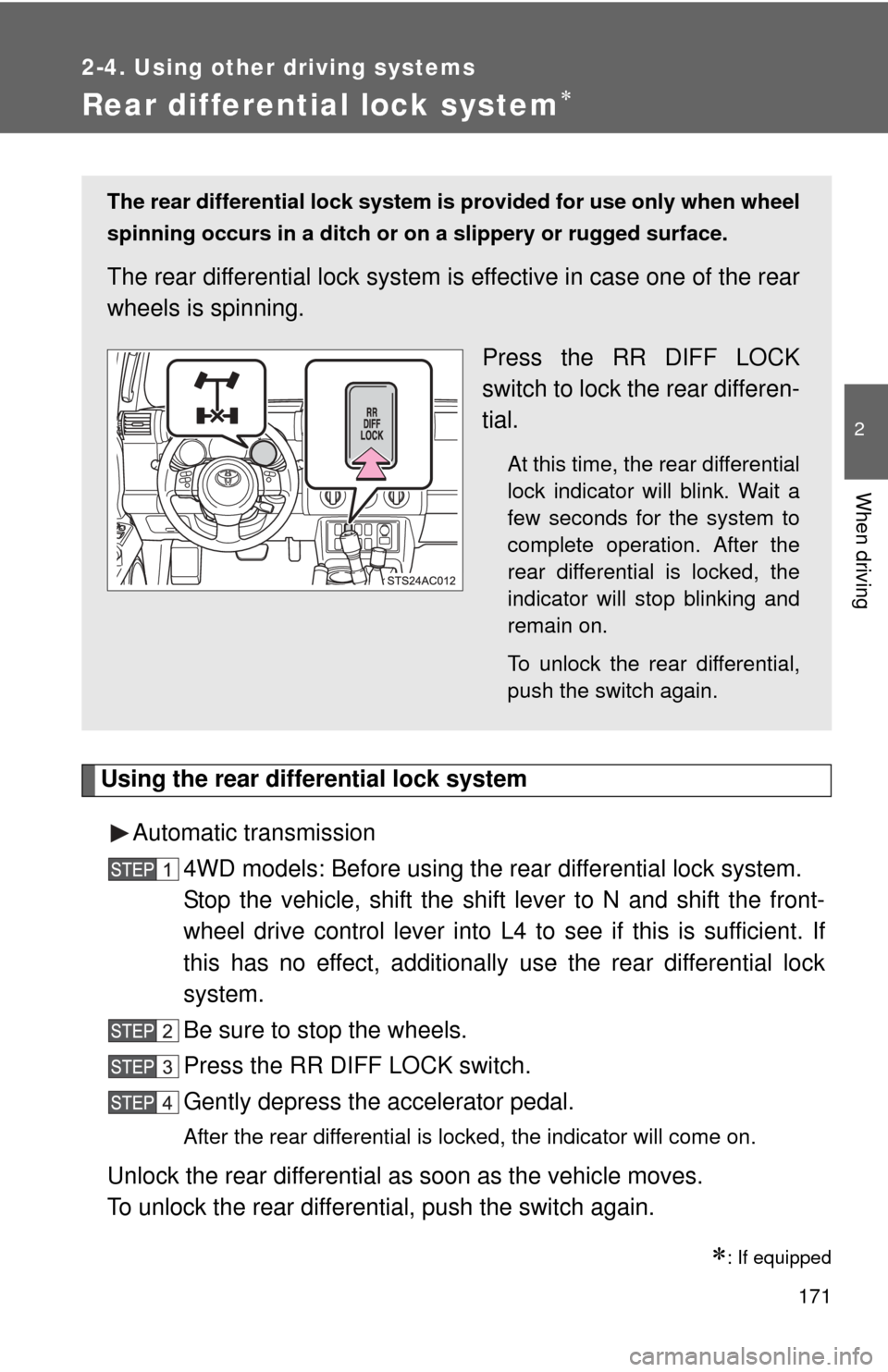
171
2-4. Using other driving systems
2
When driving
Rear differential lock system
Using the rear differential lock systemAutomatic transmission 4WD models: Before using the rear differential lock system.
Stop the vehicle, shift the shift lever to N and shift the front-
wheel drive control lever into L4 to see if this is sufficient. If
this has no effect, additionally use the rear differential lock
system.
Be sure to stop the wheels.
Press the RR DIFF LOCK switch.
Gently depress the accelerator pedal.
After the rear differential is locked, the indicator will come on.
Unlock the rear differential as soon as the vehicle moves.
To unlock the rear differential, push the switch again.
: If equipped
The rear differential lock system is provided for use only when wheel
spinning occurs in a ditch or on a slippery or rugged surface.
The rear differential lock system is effective in case one of the rear
wheels is spinning.
Press the RR DIFF LOCK
switch to lock the rear differen-
tial.
At this time, the rear differential
lock indicator will blink. Wait a
few seconds for the system to
complete operation. After the
rear differential is locked, the
indicator will stop blinking and
remain on.
To unlock the rear differential,
push the switch again.
Page 172 of 528
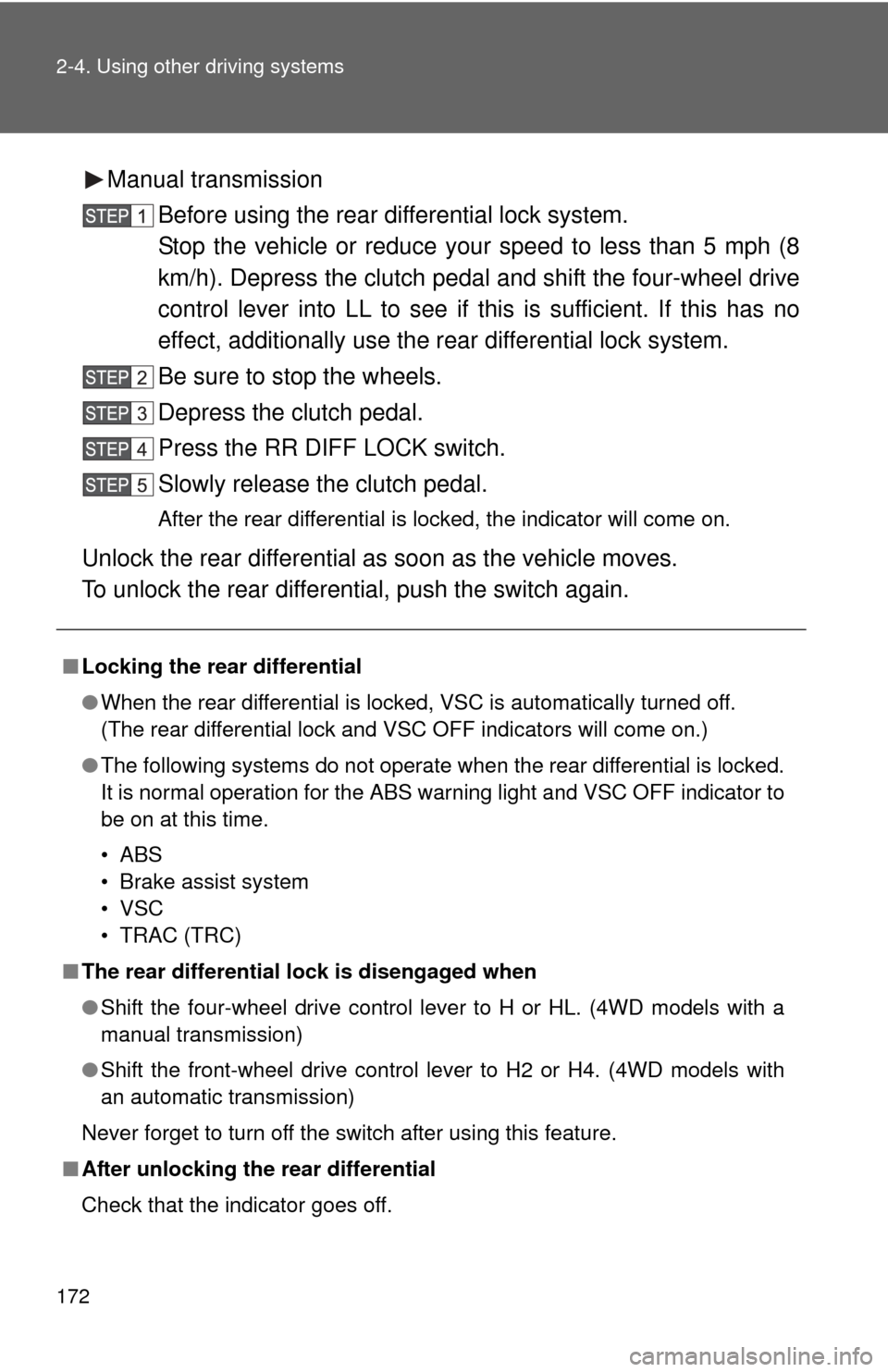
172 2-4. Using other driving systems
Manual transmissionBefore using the rear differential lock system.
Stop the vehicle or reduce your speed to less than 5 mph (8
km/h). Depress the clutch pedal and shift the four-wheel drive
control lever into LL to see if this is sufficient. If this has no
effect, additionally use the r ear differential lock system.
Be sure to stop the wheels.
Depress the clutch pedal.
Press the RR DIFF LOCK switch.
Slowly release the clutch pedal.
After the rear differential is locked, the indicator will come on.
Unlock the rear differential as soon as the vehicle moves.
To unlock the rear differential, push the switch again.
■ Locking the rear differential
●When the rear differential is locked, VSC is automatically turned off.
(The rear differential lock and VSC OFF indicators will come on.)
● The following systems do not operate when the rear differential is locked.
It is normal operation for the ABS warning light and VSC OFF indicator to
be on at this time.
•ABS
• Brake assist system
•VSC
• TRAC (TRC)
■ The rear differential lock is disengaged when
●Shift the four-wheel drive control lever to H or HL. (4WD models with a
manual transmission)
● Shift the front-wheel drive control lever to H2 or H4. (4WD models with
an automatic transmission)
Never forget to turn off the switch after using this feature.
■ After unlocking the rear differential
Check that the indicator goes off.
Page 173 of 528
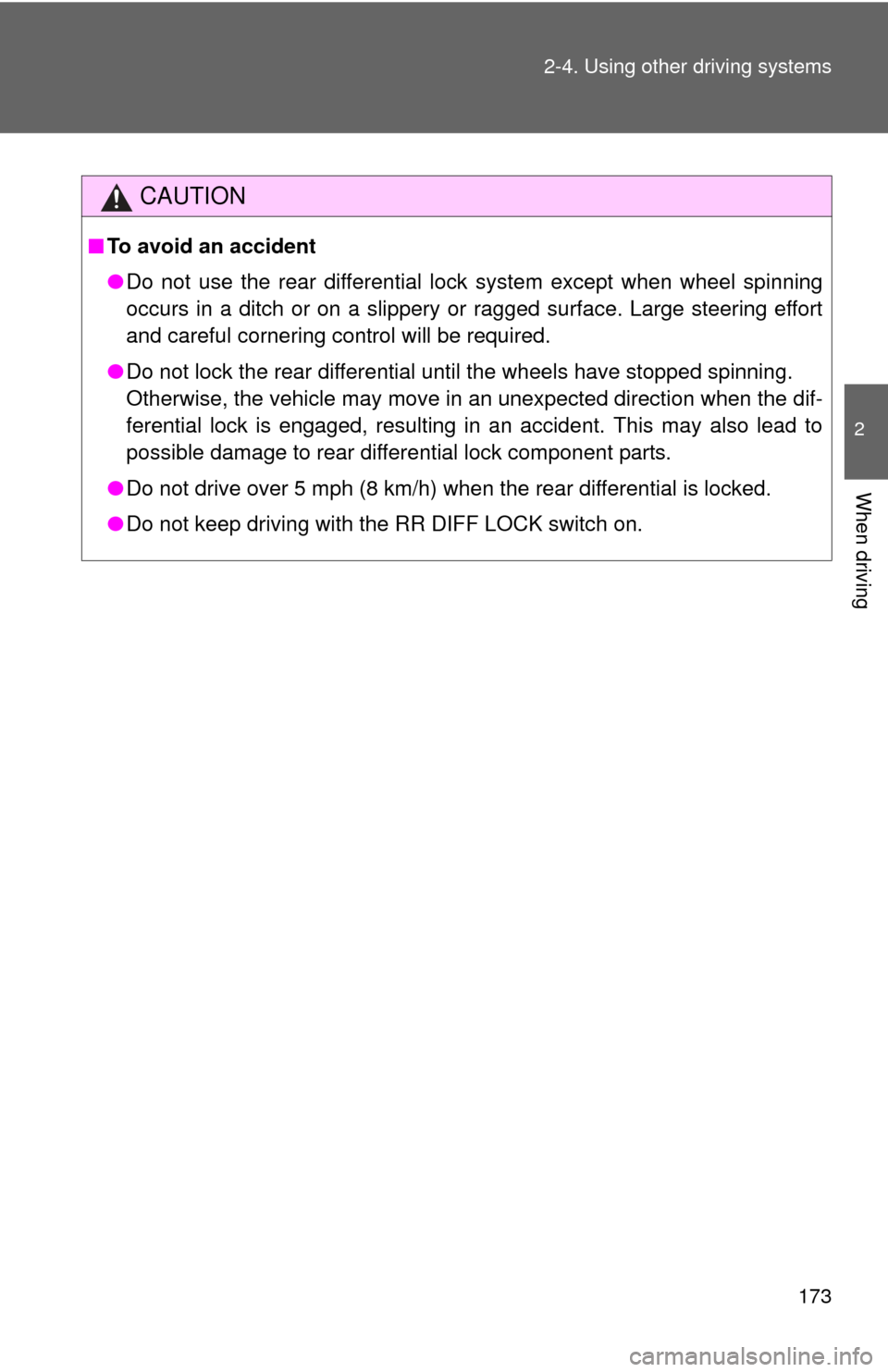
173
2-4. Using other
driving systems
2
When driving
CAUTION
■To avoid an accident
●Do not use the rear differential lock system except when wheel spinning
occurs in a ditch or on a slippery or ragged surface. Large steering effort
and careful cornering control will be required.
● Do not lock the rear differential until the wheels have stopped spinning.
Otherwise, the vehicle may move in an unexpected direction when the dif-
ferential lock is engaged, resulting in an accident. This may also lead to
possible damage to rear differential lock component parts.
● Do not drive over 5 mph (8 km/h) when the rear differential is locked.
● Do not keep driving with the RR DIFF LOCK switch on.
Page 174 of 528
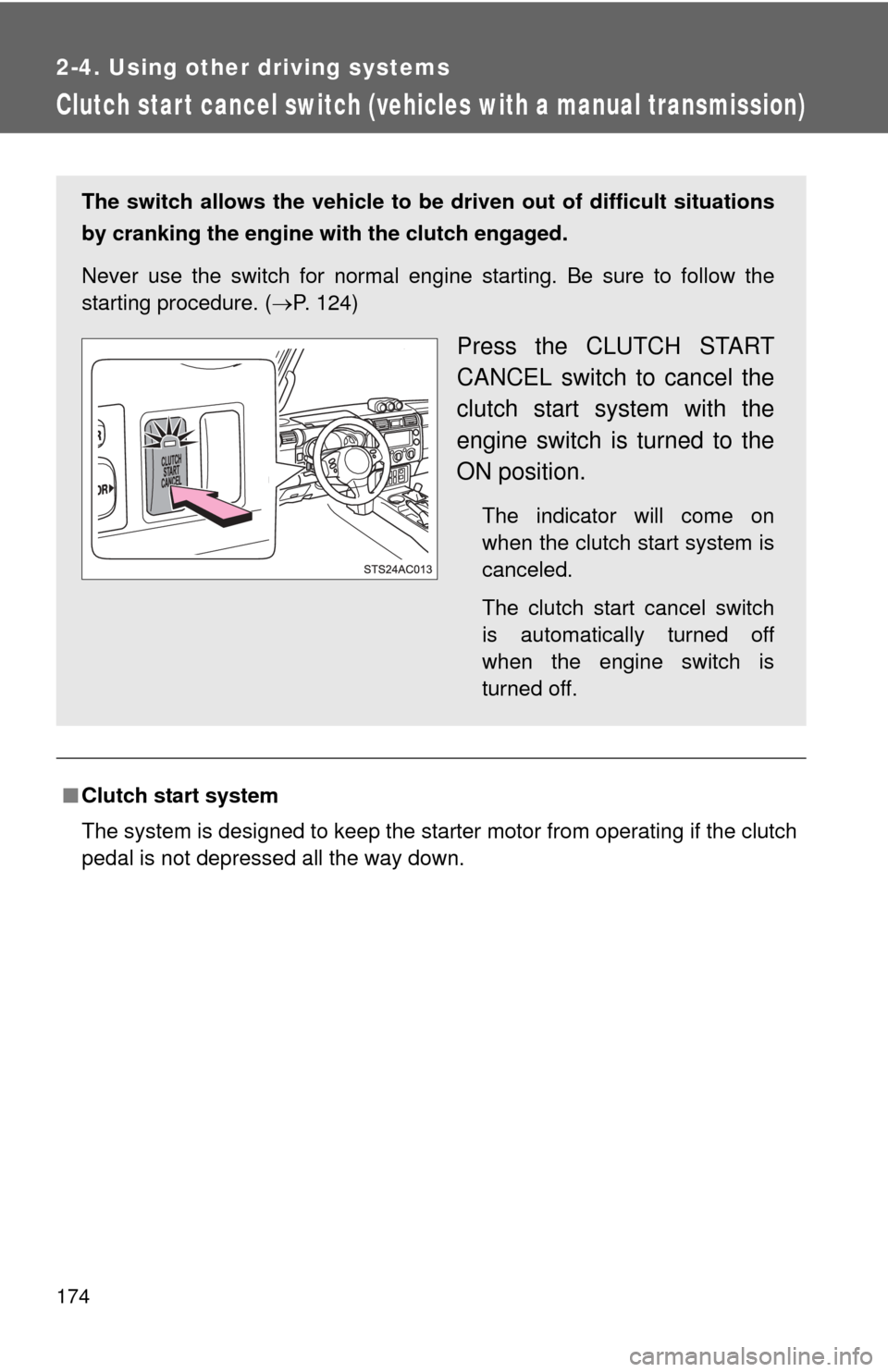
174
2-4. Using other driving systems
Clutch star t cancel switch (vehicles with a manual transmission)
■Clutch start system
The system is designed to keep the starter motor from operating if the clutch
pedal is not depressed all the way down.
The switch allows the vehicle to be driven out of difficult situations
by cranking the engine with the clutch engaged.
Never use the switch for normal engine starting. Be sure to follow the
starting procedure. ( P. 124)
Press the CLUTCH START
CANCEL switch to cancel the
clutch start system with the
engine switch is turned to the
ON position.
The indicator will come on
when the clutch start system is
canceled.
The clutch start cancel switch
is automatically turned off
when the engine switch is
turned off.
Page 175 of 528
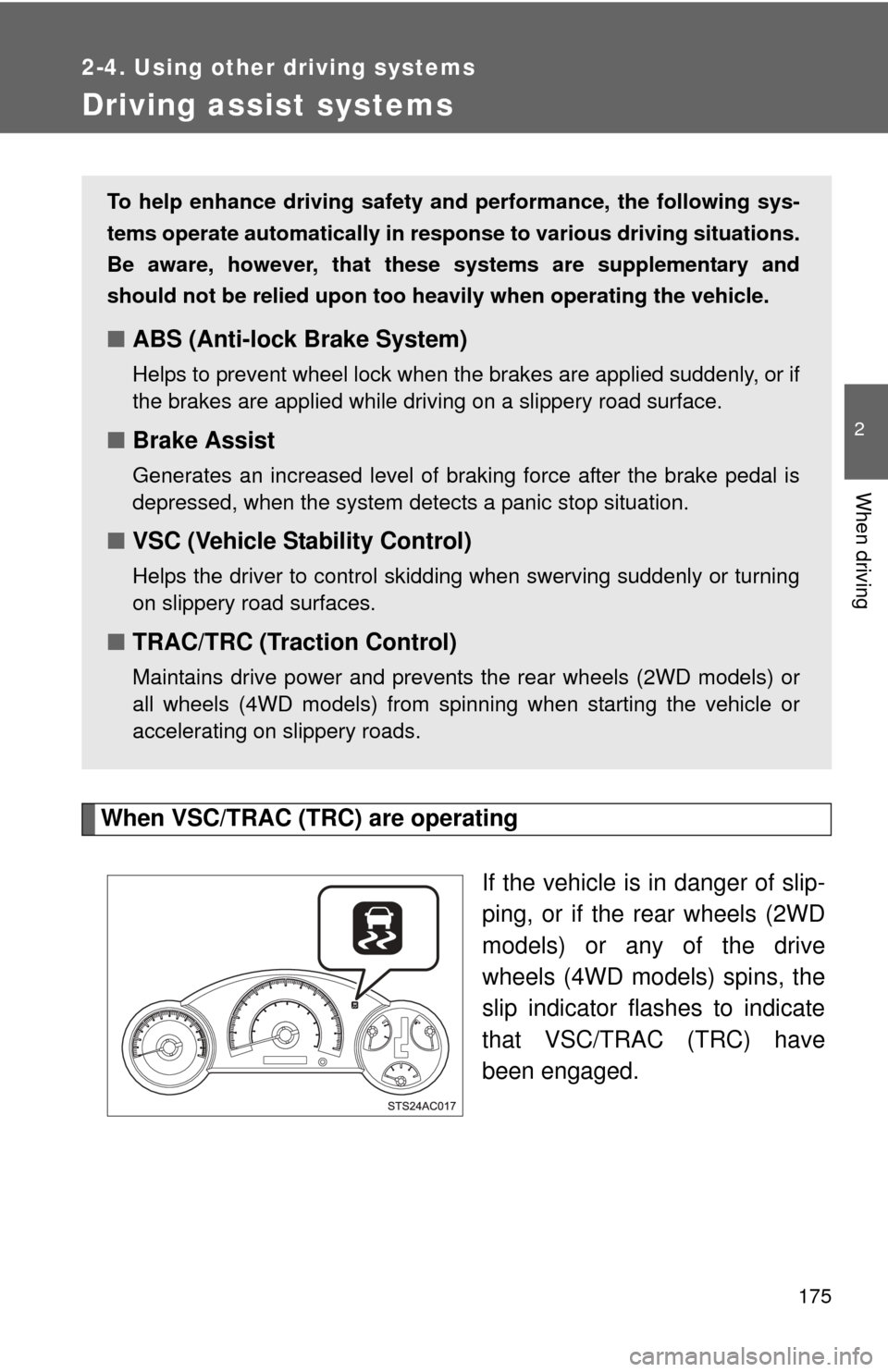
175
2-4. Using other driving systems
2
When driving
Driving assist systems
When VSC/TRAC (TRC) are operatingIf the vehicle is in danger of slip-
ping, or if the rear wheels (2WD
models) or any of the drive
wheels (4WD models) spins, the
slip indicator flashes to indicate
that VSC/TRAC (TRC) have
been engaged.
To help enhance driving safety and performance, the following sys-
tems operate automatically in res ponse to various driving situations.
Be aware, however, that these systems are supplementary and
should not be relied upon too heavi ly when operating the vehicle.
■ABS (Anti-lock Brake System)
Helps to prevent wheel lock when the brakes are applied suddenly, or if
the brakes are applied while driving on a slippery road surface.
■Brake Assist
Generates an increased level of braking force after the brake pedal is
depressed, when the system detects a panic stop situation.
■VSC (Vehicle Stability Control)
Helps the driver to control skidding when swerving suddenly or turning
on slippery road surfaces.
■TRAC/TRC (Traction Control)
Maintains drive power and prevents the rear wheels (2WD models) or
all wheels (4WD models) from spinning when starting the vehicle or
accelerating on slippery roads.
Page 176 of 528
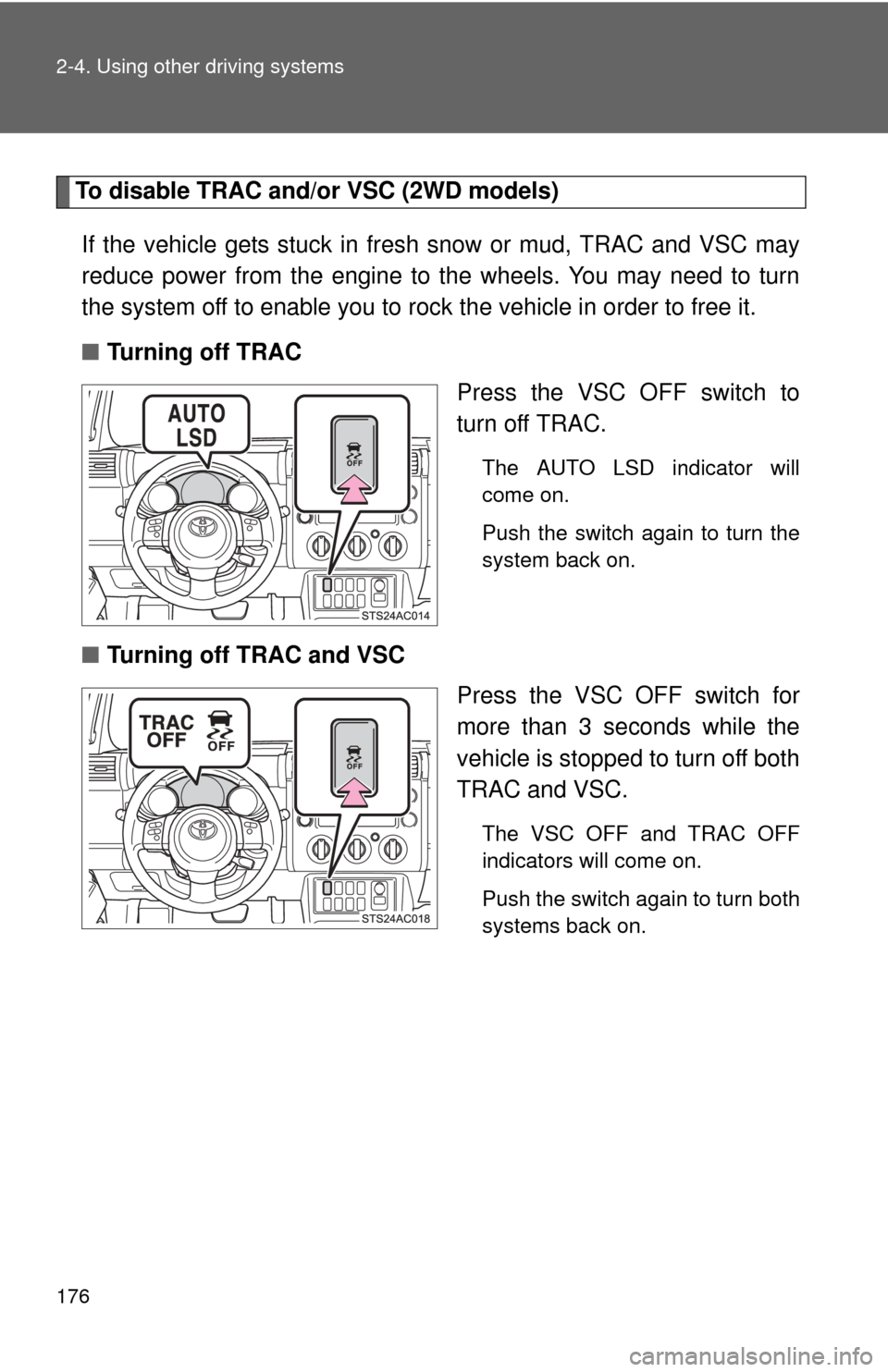
176 2-4. Using other driving systems
To disable TRAC and/or VSC (2WD models)If the vehicle gets stuck in fres h snow or mud, TRAC and VSC may
reduce power from the engine to the wheels. You may need to turn
the system off to enable you to rock the vehicle in order to free it.
■ Turning off TRAC
Press the VSC OFF switch to
turn off TRAC.
The AUTO LSD indicator will
come on.
Push the switch again to turn the
system back on.
■Turning off TRAC and VSC
Press the VSC OFF switch for
more than 3 seconds while the
vehicle is stopped to turn off both
TRAC and VSC.
The VSC OFF and TRAC OFF
indicators will come on.
Push the switch again to turn both
systems back on.
Page 177 of 528
![TOYOTA FJ CRUISER 2011 1.G Owners Manual 177
2-4. Using other
driving systems
2
When driving
To disable TRAC (TRC) and/or VSC (H2 and H4 mode [automatic
transmission] or H and HL mode [m anual transmission] on 4WD models)
If the vehicle get TOYOTA FJ CRUISER 2011 1.G Owners Manual 177
2-4. Using other
driving systems
2
When driving
To disable TRAC (TRC) and/or VSC (H2 and H4 mode [automatic
transmission] or H and HL mode [m anual transmission] on 4WD models)
If the vehicle get](/img/14/6370/w960_6370-176.png)
177
2-4. Using other
driving systems
2
When driving
To disable TRAC (TRC) and/or VSC (H2 and H4 mode [automatic
transmission] or H and HL mode [m anual transmission] on 4WD models)
If the vehicle gets stuck in fresh snow or mud, TRAC (TRC) and VSC
may reduce power from the engine to the wheels. You may need to
turn the system off to enable you to rock the vehicle in order to free it.
■Turning off TRAC (TRC)
Press the VSC OFF switch to
turn off TRAC (TRC).
The TRAC OFF (TRC OFF) indi-
cator will come on.
Push the switch again to turn the
system back on.
■Turning off TRAC (TRC) and VSC
Press and hold the VSC OFF
switch for more than 3 seconds
while the vehicle is stopped to
turn off both TRAC (TRC) and
VSC.
The VSC OFF and TRAC OFF
(TRC OFF) indicators will come
on.
Push the switch again to turn both
systems back on.
U.S.A. Canada
U.S.A. Canada
Page 178 of 528

178 2-4. Using other driving systems
■Automatic reactivation of TRAC (TRC) and VSC
Turning the engine switch off after turning off the TRAC (TRC) and VSC sys-
tems will automatically re-enable them.
■ Automatic VSC reactivation (2WD models)
If only the TRAC system is turned off, VSC OFF and AUTO LSD indicators
turn on. The VSC system will turn on when the vehicle speed increases.
■ Automatic TRAC (TRC) and VSC reactivation
If the TRAC (TRC) and VSC systems are turned off, the systems will not turn
on, even when vehicle speed increases.
■ Sounds and vibrations caused by the ABS, TRAC (TRC), VSC and
brake assist system
● A sound may be heard from the engine compartment when the engine is
started or just after the vehicle begins to move. This sound does not indi-
cate that a malfunction has occurred in any of these systems.
● Any of the following conditions may occur when the above systems are
operating. None of these indicates that a malfunction has occurred.
• Vibrations may be felt through the vehicle body and steering.
• A motor sound may be heard after the vehicle comes to a stop.
• The brake pedal may pulsate slightly after the ABS is activated.
• The brake pedal may move down slightly after the ABS is activated.
■ If the brake system overheats
TRAC (TRC) will cease operation and a buzzer will sound to alert the driver.
Stop the vehicle in a safe place. (There is no problem with continuing normal
driving.)
Page 179 of 528
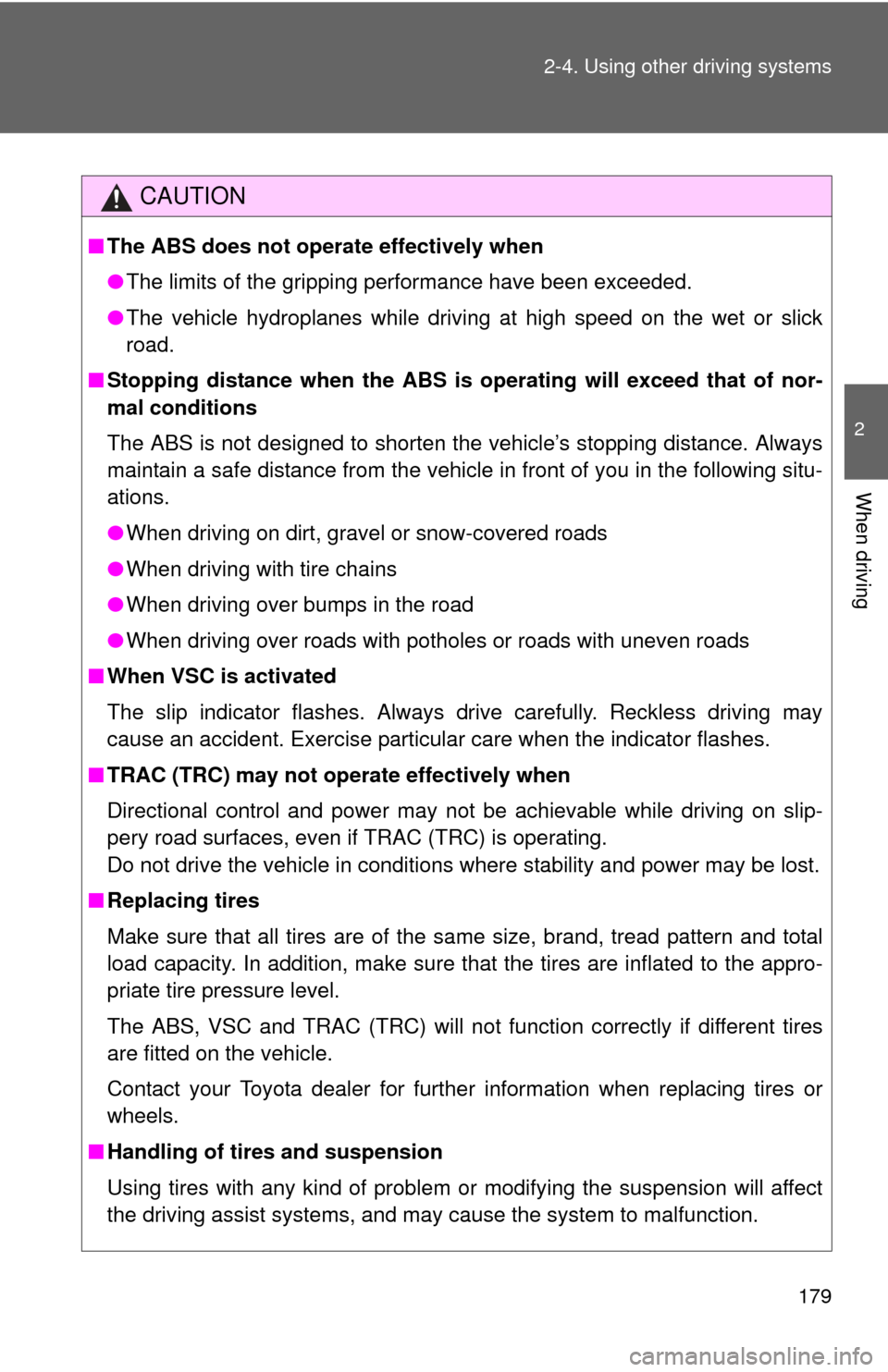
179
2-4. Using other
driving systems
2
When driving
CAUTION
■The ABS does not opera te effectively when
● The limits of the gripping performance have been exceeded.
● The vehicle hydroplanes while driving at high speed on the wet or slick
road.
■ Stopping distance when the ABS is operating will exceed that of nor-
mal conditions
The ABS is not designed to shorten the vehicle’s stopping distance. Always
maintain a safe distance from the vehicle in front of you in the following situ-
ations.
● When driving on dirt, gravel or snow-covered roads
● When driving with tire chains
● When driving over bumps in the road
● When driving over roads with pothol es or roads with uneven roads
■ When VSC is activated
The slip indicator flashes. Always drive carefully. Reckless driving may
cause an accident. Exercise particular care when the indicator flashes.
■ TRAC (TRC) may not operate effectively when
Directional control and power may not be achievable while driving on slip-
pery road surfaces, even if TRAC (TRC) is operating.
Do not drive the vehicle in conditions where stability and power may be lost.
■ Replacing tires
Make sure that all tires are of the same size, brand, tread pattern and total
load capacity. In addition, make sure that the tires are inflated to the appro-
priate tire pressure level.
The ABS, VSC and TRAC (TRC) will not function correctly if different tires
are fitted on the vehicle.
Contact your Toyota dealer for further information when replacing tires or
wheels.
■ Handling of tires and suspension
Using tires with any kind of problem or modifying the suspension will affect
the driving assist systems, and may cause the system to malfunction.
Page 180 of 528
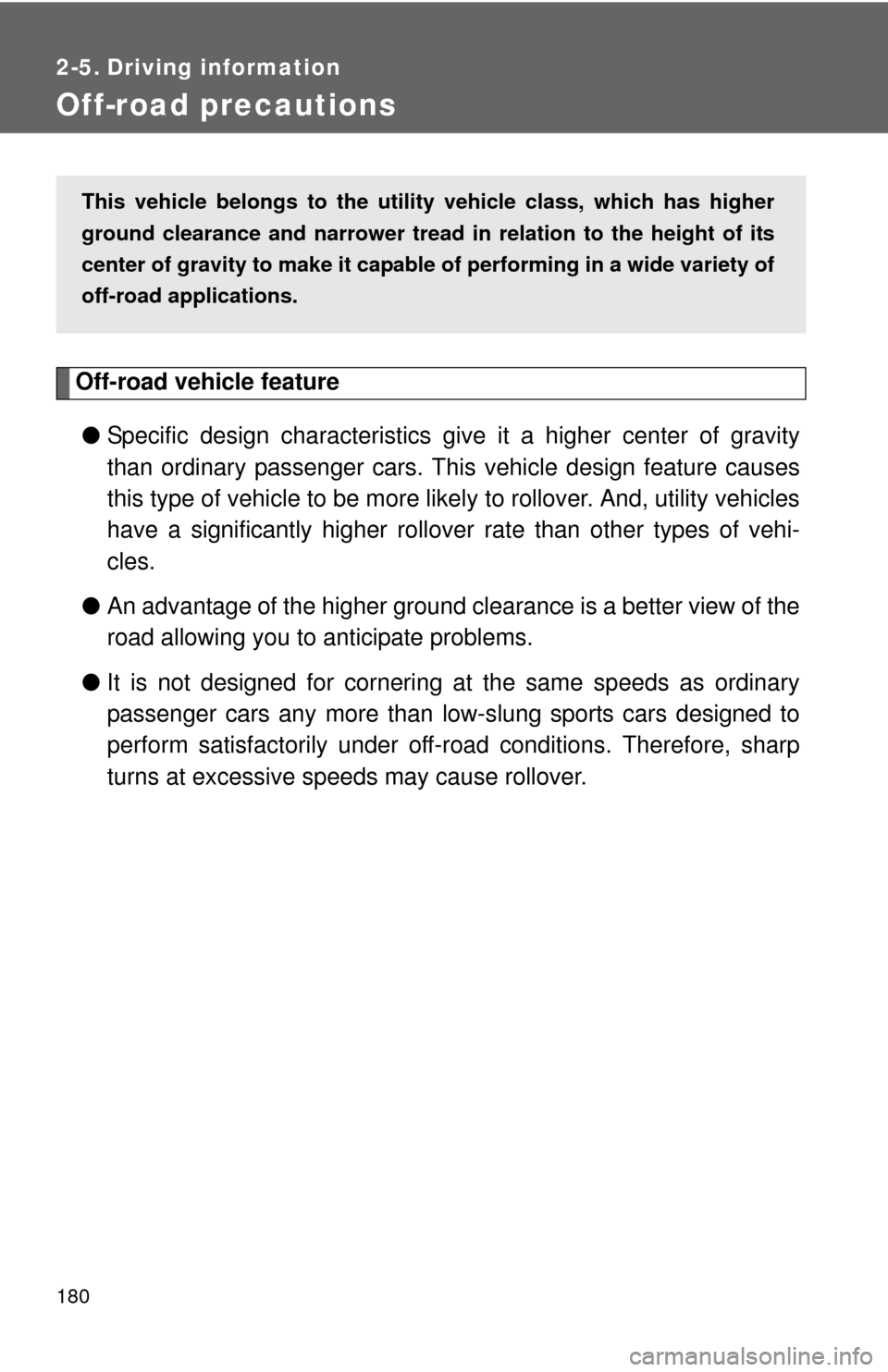
180
2-5. Driving information
Off-road precautions
Off-road vehicle feature● Specific design characteristics give it a higher center of gravity
than ordinary passenger cars. This vehicle design feature causes
this type of vehicle to be more likel y to rollover. And, utility vehicles
have a significantly higher rollover rate than other types of vehi-
cles.
● An advantage of the higher ground clearance is a better view of the
road allowing you to anticipate problems.
● It is not designed for cornering at the same speeds as ordinary
passenger cars any more than lo w-slung sports cars designed to
perform satisfactorily under off-road conditions. Therefore, sharp
turns at excessive speeds may cause rollover.
This vehicle belongs to the utility vehicle class, which has higher
ground clearance and narrower tread in relation to the height of its
center of gravity to make it capable of performing in a wide variety of
off-road applications.